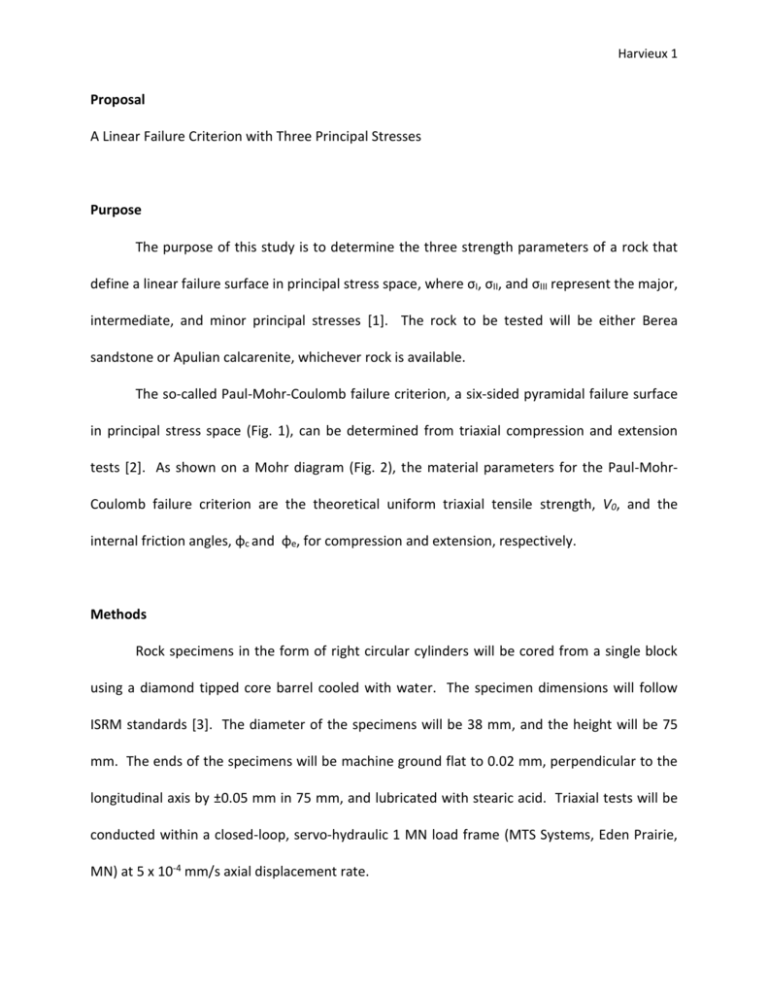Sample Proposal CSE
advertisement

Harvieux 1 Proposal A Linear Failure Criterion with Three Principal Stresses Purpose The purpose of this study is to determine the three strength parameters of a rock that define a linear failure surface in principal stress space, where σI, σII, and σIII represent the major, intermediate, and minor principal stresses [1]. The rock to be tested will be either Berea sandstone or Apulian calcarenite, whichever rock is available. The so-called Paul-Mohr-Coulomb failure criterion, a six-sided pyramidal failure surface in principal stress space (Fig. 1), can be determined from triaxial compression and extension tests [2]. As shown on a Mohr diagram (Fig. 2), the material parameters for the Paul-MohrCoulomb failure criterion are the theoretical uniform triaxial tensile strength, V0, and the internal friction angles, φc and φe, for compression and extension, respectively. Methods Rock specimens in the form of right circular cylinders will be cored from a single block using a diamond tipped core barrel cooled with water. The specimen dimensions will follow ISRM standards [3]. The diameter of the specimens will be 38 mm, and the height will be 75 mm. The ends of the specimens will be machine ground flat to 0.02 mm, perpendicular to the longitudinal axis by ±0.05 mm in 75 mm, and lubricated with stearic acid. Triaxial tests will be conducted within a closed-loop, servo-hydraulic 1 MN load frame (MTS Systems, Eden Prairie, MN) at 5 x 10-4 mm/s axial displacement rate. Harvieux 2 The elastic constants and degree of anisotropy will be determined by using ultrasonic techniques. P- and S- wave arrival times will be measured at locations along the axes. The degree of anisotropy and the elastic parameters, Poisson’s ratio and Young’s modulus, will be calculated from the P- and S- wave velocities. Triaxial compression and extension testing will be performed using stress paths of loading and unloading. Axial stress will be applied by the 1 MN servo-hydraulic load frame. Radial stress will be from a fluid pressure system with a microcontroller and a screw-type hydraulic intensifier. Hydraulic pressure will be controlled by advancing or retracting a stepper motor in response to the system volume changes. To construct a best-fit line, at least three data points are needed for each of the four stress paths. Thus, six tests will be in compression, where σI= σa and σII= σIII= σr, and the other six will be in extension, where σI= σII= σr and σIII= σa. Three of the compression tests will be loading tests, where σa increases until failure. The other three compression tests will be unloading, where σr decreases until failure. Three of the extension tests will be loading, where σr increases until failure. The other three extension tests will be unloading, where σa decreases until failure. Data from these tests will be used to create a p-q plot of compression and extension 1 states where 𝑝 = 3 (𝜎𝑎 + 2𝜎𝑟 ) and 𝑞 = (𝜎𝑎 − 𝜎𝑟 ). A common vertex V0 will be calculated from the plot by using data fitting techniques. The φc and φe will be calculated by the data fitting techniques as well. From this, a hexagonal pyramid failure surface can be constructed. Harvieux 3 Outcome This research will compliment other related studies of rock failure [4, 5] by determining the strength parameters. The triaxial tests and data fitting techniques will determine V0, φc, and φe, along with a π-plane, and a hexagonal pyramidal failure surface. The results for this research project will determine if the rock follows the Paul-Mohr-Coulomb failure criterion, including how well it fits the six-sided pyramidal failure surface model. Another outcome is that the tests and calculations will display any uncertainties in the data fitting the failure criterion model. References 1. Paul B. Generalized Pyramidal Fracture and Yield Criteria. International Journal of Solids and Structures. 1968; 4: 175-196 2. Meyer JP, Labuz JF. Linear Failure Criteria with Three Principal Stresses. International Journal of Rock Mechanics and Mining Sciences. 2012. 3. Brown ET. Rock Characterization, Testing and Monitoring: ISRM Suggested Methods. International Society for Rock Mechanics. 1981; Pergamon Press. 4. Al-Ajmi A, Zimmerman R. Relation between the Mogi and the Coulomb failure criteria. International Journal of Rock Mechanics and Mining Sciences. 2005; 42: 437. Accepted 5 November 2004. Available online 13 January 2005. 5. Haimson B, Rudnicki J. The effect of the intermediate principal stress on fault formation and fault angle in siltstone. Journal of Structural Geology. 2009; 32: 1701-1711. Accepted 25 August 2009. Available online 11 September 2009. Harvieux 4 Figures Figure 1 Six-sided pyramidal failure surface Figure 2 Mohr diagram with two internal friction angles





